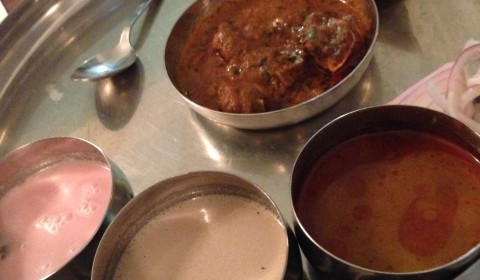Maharashtrian food changes as you move inland. The landscape becomes rugged as the Arabian sea is left behind. Not surprisingly, the food changes as well. This is where south Indian influences start showing. Beyond Maharashtra lie the south Indian states, each having their distinct cuisine and cooking styles.
My journey brought me 7 hours inland to Kolahpur, towards the south western part of Maharashtra. The picturesque western ghats add to it’s allure. This city is known all over for the leather slippers that are made here. This city is also known for its favourite dish, Kolahpuri mutton. Having eaten this dish on numerous occasions in many places, I realised each variation was different from the other.
Recently, I came across a very red and deceptively mouth burning powder at work. I inquired and found out this Masala hails from Kolahpur, where a family sends these to us. This masala was used in our version of Kolahpuri gravy. I also remember being pleasantly surprised when it’s mixed with butter and spread on toast. I never once wondered what it contained. Needless to say, Kolahpuri mutton is what brought me here. I had a feeling I would see this red masala again.
Kolahpuri food is unique because it combines ingredients of Maharashtra and iconic south Indian techniques such as grinding masalas. Non-vegetarian food is taken very seriously here, especially goat. When cooked in traditional ways, this region is home to some of the most complex curries in the country. This sort of cuisine is very popular in Mumbai thanks to the various Kolahpuri restaurant chains.
Naik e Kolahpuri is a family-run restaurant near the bus station. Here, I was given a crash course on the basics of this cuisine. I asked for the signature mutton based thali.
The main dish, Kolahpuri mutton in this case, was served with rice and “Bhakrai”, a flatbread made with jowar flour, a locally found millet, very high in fiber. To balance out the heat and spice of the gravy, 4 soup like dishes are served alongside.

Two bowls featured a very unique south Indian ingredient, Kokum. The outer skin of this fruit is fried and used in place of tamarind in parts of Goa, Gujarat and Karnataka. This particular pink soup is called “agal”. This is made by combining Kadhi, a thin yogurt based sauce common in Gujarati and Rajasthani cuisine. Kadhi, minus kokum, is also served as an accompaniment. This Kolahpuri style kadhi is called Solkadhi.
Rassa comes from the word “rassam”, a dish very popular in south India. Rassam is a thin tomato stock usually consumed as an aperitif. Unlike rassam, a rassa is cooked in chicken or lamb stock, making it more savoury and flavoursome. Unsurprisingly, Rassa also means soup.
This thali meal included only 2 types of rassa ; a white one,”Pandhra” and a red one “Tambda”.
Pandhra rassa is a rich, velvety cashew soup. Cashew is abundant in these areas and is thus made into a paste. This paste is added to meat stock. Adding coconut milk makes this soup taste really special.
Tambda rassa is red because it is stock, simmered with a very special masala.
This masala I knew. This masala I remember. This masala was special.
Now, What exactly is a masala?
In this context, A masala is a combination of ingredients that combine to give a dish flavour, colour, taste and heat. In most cases, it serves all 4 purposes. These ingredients could be cooked or raw. Then they are pounded to form a paste or powder in a mortar and pestle, nowadays in a food processor.
Every state has its own masala mix. This makes food from every state different from each other. The uses of these masala combinations increases as you go south of the country.
I wasn’t too excited about eating the mutton as much as I was to try the gravy. In truth, I wasn’t after the mutton at all. I was after the elusive Kolahpuri masala. Something so elusive, that it is considered bad luck to take it outside your home after dark. They call it “Kolhapuri Garlic Chutney”, a red powder which uses fried onion, fried coconut, garlic and dried chilly in measured proportions. It uses a special red pepper found in this area, making this masala even more sought after. This contains oil and salt as well. In fact, salt is not added to food when this masala is used in the same dish. This masala is added to a normal curry to give it that distinct taste and flavour, resulting in an authentic Kolhapuri mutton. Easy right?
Probably not, because preparing this masala isn’t exactly easy. It takes experience to get the proportions and colour right. If perfection is achieved, the resulting curry is worth the effort. If not, it’s just like any generic spicy red curry found anywhere else.
These masala combinations give a dish character. Ingredients such as coconut and spices are found extensively in these areas. This is why they become more common as one moves south. Kolahpuri cuisine is concentrated over a very small area. I’ve heard if you go further south, a place called Solapur uses a similar masala, the only exception is that the latter is black, possibly due to adding black pepper. This area lies between mainland Maharashtra and northern Karnataka. In a way, between two very different cultures. This cuisine, in my opinion takes the best of both worlds and results in one of the most complex cuisines anywhere in India. My journey to Kolahpur was worth it.
Sadly, tradition disallowed me to take any masala back with me.
